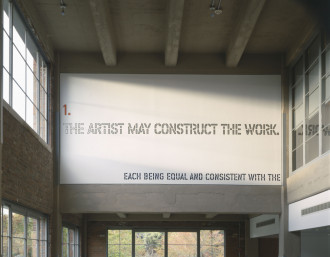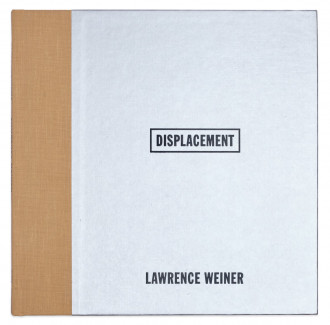Lawrence Weiner
Long-term view, Dia Beacon
Overview
Language is a dominant aspect of Lawrence Weiner’s practice. Conceived as objective representations of states or processes rather than material realities, Weiner’s works are capable of countless manifestations. Although their content is general and abstract, they remain inseparable from their presentation and context. These works could be defined as site-related; they are conceived in relation to the venue and circumstance. Whether the letters are stenciled, painted, or mounted in relief, the choice of typeface, size, placement, and color, varies with the site. The context serves as a vital factor for Weiner’s works. A poster, artist’s book, gallery, or public arena molds the work’s meaning.
Various and versatile, Weiner’s works at Dia Beacon remain dispersive. Visitors interact with them among the sculpture galleries, in a stairwell, and in the café/bookshop. Suspended high over the admissions desk, the artist’s Statement of Intent (1969) attests to his belief that “art always institutionalizes itself,” regardless of placement. Such an active arrangement emphasizes the work of art is completed only through a viewer’s potential reception and adoption.
All guided tours of Lawrence Weiner’s CADMIUM & MUD & TITANIUM & LEAD & FERROUS OXIDE & SO ON . . . (1991) are paused pending conservation.
Lawrence Weiner formulates his work through language. For him, language provides a medium for representing material relationships in the external world as objectively as possible. His statements are produced with minimal traces of authorial subjectivity; his works offer little evidence of the artist’s hand, skill, or taste. “Art is not a metaphor upon the relationship of human beings to objects and objects to objects in relation to human beings but a representation of an empirical existing fact,” Weiner argues. “It does not tell the potential and capabilities of an object (material) but presents a reality concerning that relationship.”
Weiner contends that an individual artwork need never be realized, since “each being equal and consistent with the intent of the artist, the decision as to condition rests with the receiver upon the occasion of receivership.” The artist’s Statement of Intent from 1969 begins:
- the artist may construct the work
- the work may be fabricated
- the work need not be built
Because Weiner’s works are conceived as nonspecific representations of states or processes rather than material realities, they are capable of countless manifestations. Although their content is general and abstract, it is inextricable from their presentation and context. Seldom site-specific, these works can be site-related—that is, conceived in relation to the venue and circumstance. The typeface, size, placement, and color all vary with the site, as does the choice to stencil, paint, or mount, in relief, the letters. The context—whether a poster, artist’s book, gallery, or public arena—also inflects the work’s meaning.
Weiner has said, “I really believe that the subject matter of my art is—art.” While sculpture has become his primary focus, earlier pieces addressed painting, the artist’s medium of choice early in his career. Presenting a single formula that equals the work, ONE QUART EXTERIOR GREEN INDUSTRIAL ENAMEL THROWN ON A BRICK WALL (1968) alludes to the Abstract Expressionism of Jackson Pollock. Weiner actually fabricated this work, as he did with a few others. In hurling paint against the facade of his home, he effectively extended Pollock’s gesture into the real world. Various and versatile, Weiner’s works at Dia:Beacon appear at physically dispersed sites—among the sculpture galleries, in a stairwell, and in the café/bookshop. Suspended high above the admissions desk, the Statement of Intent attests to his belief that “art always institutionalizes itself,” irrespective of placement. It also reminds visitors that the work of art is completed in its reception, understanding, and potential enactment.
Stairwell:
ONE QUART EXTERIOR GREEN INDUSTRIAL ENAMEL THROWN ON A BRICK WALL, 1968
Language + the materials referred to
Collection Alice Zimmerman-Weiner; Long-term loan
Café/bookshop:
Statement of Intent, 1969
Language + the materials referred to
Public freehold; Courtesy the artist
Lawrence Weiner was born in the Bronx, New York, in 1942. After graduating from high school, he traveled across the country to California, where, in 1960, he used dynamite to create his Cratering Piece in Mill Valley. His first solo show was held at Seth Siegelaub Contemporary Art, New York, in 1964. In 1968 he presented Statements, a book of works composed solely of language, and since then he has continued to explore the capacities and presentation of language as a sculptural medium. Weiner has had solo exhibitions at venues including the Kunstmuseum Wolfsburg, Germany (2000), the Walker Art Center, Minneapolis (1991 and 1994), the Hirshhorn Museum and Sculpture Garden, Smithsonian Institution, Washington, DC (1990), and the Whitney Museum of American Art, New York (2007). In 1991 Dia presented his work Displacement and published an accompanying book of the same title. Weiner currently lives between New York City and Amsterdam.
Artist
Lawrence Weiner
(1942–2021)
Lawrence Weiner was born in New York City in 1942. He died in New York City in 2021.
Selected Works on View

Lawrence Weiner
5 Figures of Structure, 1987
Go to 5 Figures of Structure page
Lawrence Weiner
Declaration of Intent, 1969
Go to Declaration of Intent page
Lawrence Weiner
ONE QUART EXTERIOR GREEN INDUSTRIAL ENAMEL THROWN ON A BRICK WALL, 1968
Go to ONE QUART EXTERIOR GREEN INDUSTRIAL ENAMEL THROWN ON A BRICK WALL page
Lawrence Weiner
CADMIUM & MUD & TITANIUM & LEAD & FERROUS OXIDE & SO ON . . ., 1991
Go to CADMIUM & MUD & TITANIUM & LEAD & FERROUS OXIDE & SO ON . . . pageBooks
Lawrence Weiner: Displacement Poster
Artist’s poster. Printed black offset on cream paper.
Lawrence Weiner: Displacement
Catalogue and artist book from the exhibition Displacement at Dia, April 1991–February 1992.
Explore
Erica Baum on Lawrence Weiner
Move to Erica Baum on Lawrence Weiner page



